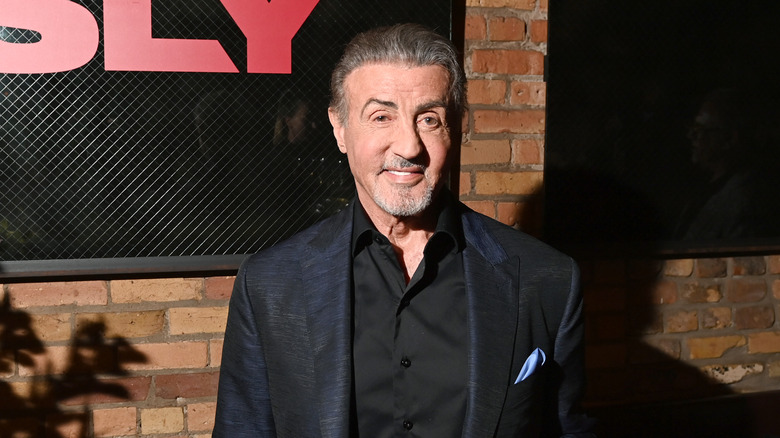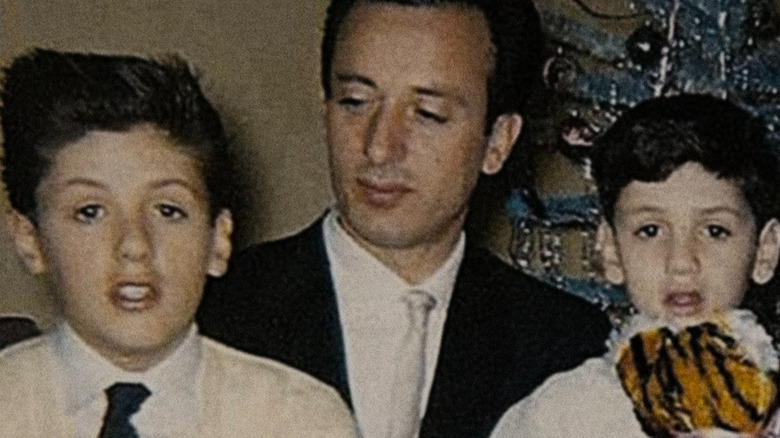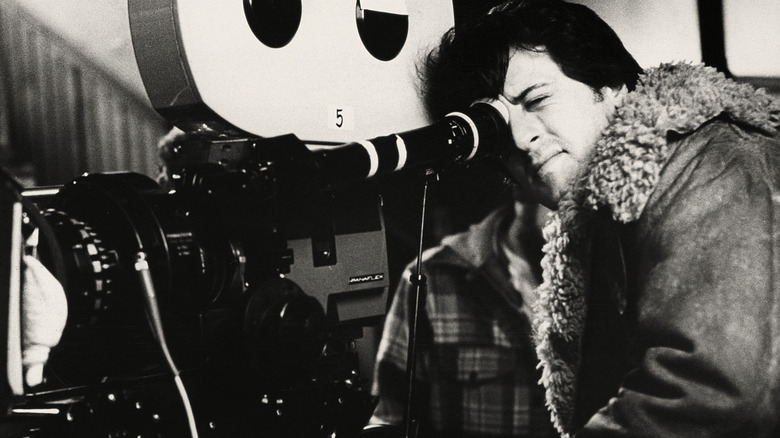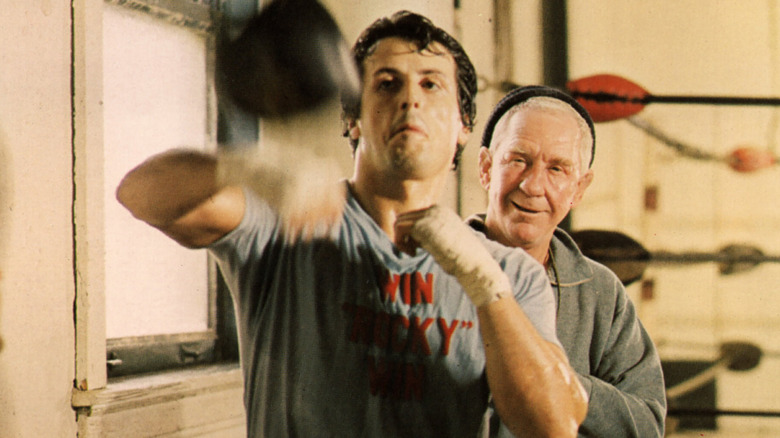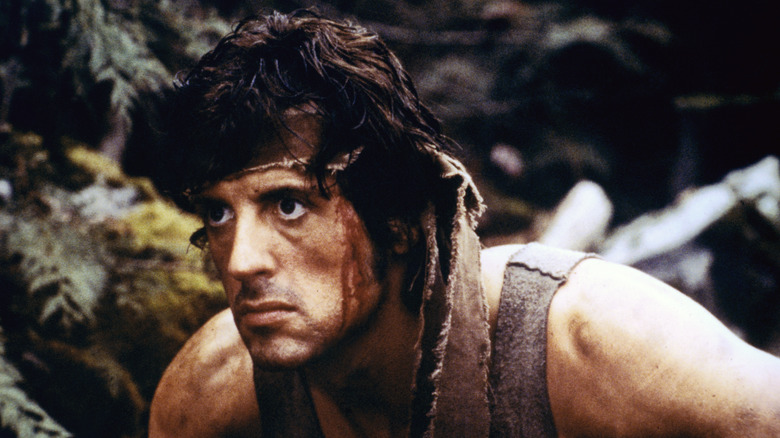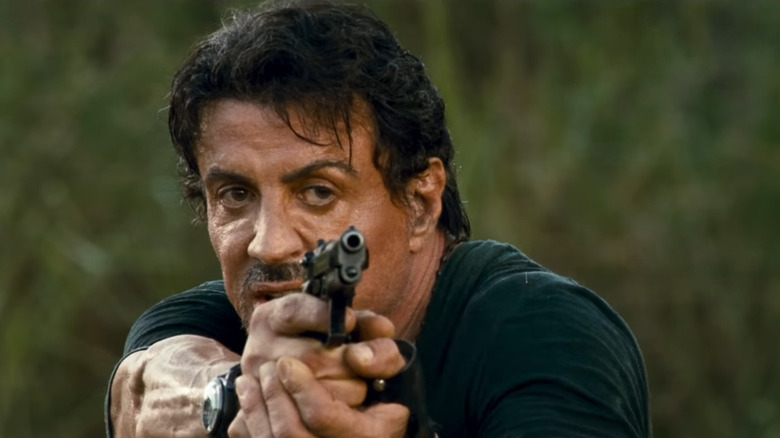Sly: The 5 Most Touching & Tragic Sylvester Stallone Facts In Netflix's New Doc
For decades, Sylvester Stallone's star turns as characters such as Rocky Balboa and John Rambo have entertained audiences the world over. But leading such a life wasn't without its fair share of challenges, as fans are now learning about in the documentary, "Sly."
Directed by Emmy-winning filmmaker Thom Zimny, the Netflix doc gives fans an unprecedented and deeply personal look into the life and career of Stallone, from his upbringing on the rough streets of Hell's Kitchen to his triumphs with "Rocky" and "First Blood" to his current ventures where he is preparing to move to a new home. Viewers are treated to never-before-seen, behind-the-scenes footage from some of Stallone's most beloved works, as well as interviews with such figures as Frank Stallone Jr., Talia Shire, Henry Winkler, Arnold Schwarzenegger, John Herzfeld, and Quentin Tarantino.
Even if you consider yourself a Stallone superfan, you're bound to gain a new level of appreciation for his craft after watching the film. The rich and complex story has too many highlights to note, but here are a few notable snippets from "Sly" that are hard to forget.
Stallone's rough relationship with his father influenced many key aspects of his career
Sylvester Stallone was born and raised on the tough-as-nails streets of Manhattan's Hell's Kitchen by Frank Stallone Sr. and Jacqueline Stallone. Growing up in the household was a rough ordeal for both Sylvester and his brother, Frank Stallone Jr., who stated in the film, "Our mother and father — it was like clockwork, I'd be up in bed and you'd just hear them screaming and yelling."
Sly makes note of his father's physically abusive tendencies, particularly two key traumatizing memories involving games of polo. His father got into the sport after moving to Maryland and Sly started playing professionally at age 13. During one game, his father continuously criticized Sly from the stands before getting on the field and ripping him from his horse. This moment halted Sylvester from playing the game until he turned 40, when he competed against his father. Frank Stallone Sr. struck his son while riding, throwing him to the ground and hurting his back. The incident prompted Sylvester to sell his horse and polo supplies, vowing to never play the game again.
Acting as an overwhelming symbol of pain and anger in his life, Sly's dad served as an inspiration for many of his key characters. Stallone called upon the built-up frustration towards his father during Rocky's argument with Mickey (Burgess Meredith) in his apartment in the original "Rocky." Similarly, many of John Rambo's grimaces and aggressive tendencies originated from Stallone's dad.
Writing was a way to get him roles
Sylvester Stallone started acting while attending college. He was first cast in a stage production of "Death of a Salesman." After receiving encouragement from a Harvard professor who viewed the play, Stallone moved to New York to pursue acting as a career. His time in the big city proved difficult as agencies turned him down and the performer only managed to get bit parts, usually in thuggish roles.
Instead of letting the industry get the best of him, Stallone took destiny into his own hands and got to creating roles of his own by writing screenplays. Often with the help of his friend, future director John Herzfeld, Stallone penned 16 screenplays over several years. During this time, the two dedicate their weekends to writing. In 1971, they even set out to make their own amateur epic with the film "Horses," which told the story of a resurrected Native American and cowboy who were being pursued by a vengeful sheriff played by Stallone's real father.
It wouldn't be until Stallone starred as Stanley Rosiello in 1974's "Lords of Flatbush" that the actor came to a realization that would change his life. "At that point, I knew forever that my fate was determined on the pen," he shared in the documentary. "'Cause I knew I was so hard to cast. I was always cast as a thug. I go, 'Okay, that's true, I am.' But I'm also nice. I'm kind of a soft touch. If you could put that together that would really be a great character."
Rocky defied the odds in more ways than one
Perhaps Sylvester Stallone's most revered screen persona, the significance that Rocky Balboa played in the once-struggling actor's life can't be overstated enough. But before becoming the box office-breaking and best picture-winning hit we know it as today, "Rocky" faced an endless list of dilemmas.
Trouble ensued even before the cameras rolled. Both Carl Weathers and Talia Shire — whose respective roles as Adrian Balboa and Apollo Creed have since become iconic — were last-minute additions to the cast, as the production struggled to find actors. One place where the team wasn't able to secure performers was the ice rink scene where Rocky and Adrian share their first date. With none of the planned extras available and only two hours allotted to shoot the scene, Stallone reworked the sequence into the small-scaled, yet warm-hearted exchange we know and love today.
Stallone and company didn't think they'd find such a nifty save as the film was preparing for its premiere. A nasty review from New York Times film critic Vincent Canby and a disappointing matinee screening five days prior to its wide release killed the team's confidence, with many convinced it would be a box office disaster. Their worries washed away when the movie was unveiled, however, with audiences becoming so engrossed during Rocky's final fight against Creed that cheers could be heard from outside the theater.
First Blood had some had disturbing real life influences
The success of "Rocky" launched Sylvester Stallone into international stardom practically overnight. After struggling with follow-up efforts such as "F.I.S.T." and "Paradise Alley," he birthed his next iconic character with the troubled Vietnam War veteran John Rambo in "First Blood." Despite the character's tough exterior, Stallone knew that creating Rambo would require a more sensitive hand.
While researching for the part, Stallone came across the accounts of several real-life Vietnam vets. Fascinated by these deeply traumatic yet moving true stories, he wanted to find a way to implement these realities into the character. "And I thought, 'Wow, if I could put a couple of beats from about 20 different guys' lives, jumble them up ... Because Rambo hasn't spoken in years so he's not coming out fluid," Stallone says in "Sly." "It's just this rush, this purging." In particular, Stallone gravitated towards the story of a man who entered a Saigon with a rigged shoeshine box, which would be the basis for Rambo's tear-jerking final speech.
The original ending of "First Blood" saw Colonel Samuel Trautman (Richard Crenna) shoot Rambo in a glorified manner. Stallone protested the ending and even threatened to exit the production, wanting to respect the experiences of actual war veterans. Following a poor test screening in Las Vegas, the ending was replaced with one in which Rambo is taken into custody.
The Expendables did everlasting damage to Stallone's body
Given the physically demanding roles Sylvester Stallone is known for, it's no surprise that the actor's body has taken its fair share of damage over the years. In "Sly," he makes special mention of his fight with Dolph Lundgren in "Rocky IV," which left him in the hospital for nine days.
However, Stallone's injuries from "Rocky IV" are nothing compared to the hard knocks he took in 2010's "The Expendables." As Stallone was getting up in years, fans and critics noted that he was no longer suited for the action-heavy roles of his heyday. However, after attending a rock and roll revival event and seeing the admiration fans still had for the long-retired celebrities, Stallone came up with the idea for a film where once-major action stars of the '80s and '90s would team up for a new adventure.
However, his commitment to the concept came with a hefty and painful price. "Truthfully, I never fully recovered from 'Expendables 1,'" Stallone explained. "It did such a number on my body I've never been the same. Never." The documentary shows several archival recordings of Stallone's many hospital visits and X-rays that detail his extreme injuries. The production was especially difficult on his wife and children, who were close to him during the shoot and witnessed his many mishaps.
